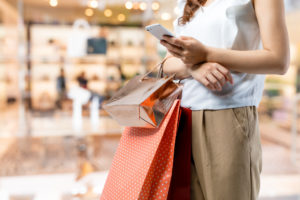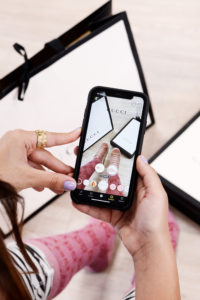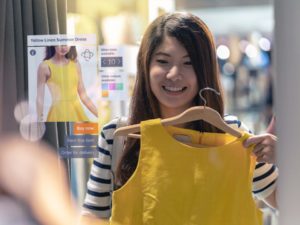Our summary below gives you an idea of the findings from our recent research conducted with Snap Inc, but if you’re interested in a more detailed view, click here to download the full report.
The growth of online shopping has undoubtedly disrupted bricks-and-mortar retail over recent years, further accelerated by Covid-19.
But mobile and technology have helped to inspire connected retailers to contribute to the increasing overlap between online and physical environments, now so fundamental to consumer life. So, rather than sounding the final bell for bricks-and-mortar retail, mobile and technology are driving a shift that benefits both shoppers and retailers.

The future is most definitely omni-channel, as our recent study with Snap Inc.* highlights. In it, we sampled 20,000 consumers from across 12 global markets, representing UK, Europe, North America, APAC and MENA, to reveal how their shopping behaviours have been impacted in the last year as the world has contended with retail store closures, stay-at-home restrictions and social distancing measures.
A new image of shopping has emerged which clearly shows that rather than existing separately, physical stores and e-commerce increasingly cross over and there is huge opportunity for everyone where they meet.
Retail brands, ahoy! We’re about to highlight 3 of 7 key themes from our study and report on the blurring of consumer needs and expectations for online and in-store shopping.
So, as the high street reopens, and in droves we crave the social and tactile experiences we have missed during COVID-19, it could well be time to digitalise your customer experience.
The Connected Shopper:
Mobile devices are increasingly becoming the core tool connecting consumers throughout all aspects of their shopping journeys – helping to optimise choice, aid discovery and facilitate social interaction.
Mobile is already the preferred channel for 34% of global consumers when shopping for products, second to shopping in-store at 43%, and stretching ahead of shopping on PCs at 23%.
And mobiles are also a companion tool when shopping in-store – used by half of shoppers to stay connected in-store, comparing prices, phoning friends, sharing photos, and finding out more about what’s on physical shelves in real time. The opportunity for retailers is in harnessing the power of mobiles in-store, to keep connected shoppers informed and entertained within their brand ecosystem.
5G connectivity will only bolster expectations of how shoppers can use their devices out of home and on the go, enabling seamless movement from real life to mobile channels.
And, as if not enough, mobiles are essential for both shopping online and in-store.
40% of global consumers say they have shopped on their mobile more since the start of the pandemic. 31% now shop online on mobile devices weekly, and 46% of shoppers say they would never go shopping without using their mobile, rising to 50% of Gen Z and millennials.
Mobiles have become an extension of the physical retail store.
50% of shoppers say they use their mobile in-store to compare prices, as well as looking for product reviews and other information. 1 in 5 say they always do this on their mobile when in store, rising to around 3 in 10 Gen Z and millennials. With this level of mobile traffic in physical retail environments, it is clear there are opportunities for retailers to capitalise on this behaviour and keep shoppers within their brand ecosystem when using their mobiles in store.
Phew! That’s a lot of being mobile. But remember this: mobile holds the key to omnichannel. By encouraging your shoppers to use mobile experiences in-store, there is an opportunity to connect the physical and digital world and keep consumer loyalty to a particular brand.

Shoppers have become accustomed to the benefits of shopping online, and as they return to store, staying connected via mobiles to maintain the practical benefits of e-commerce – price comparison, research, and reviews – alongside the experience only a physical store can deliver, can combine to create a winning formula.
And so, for avoidance of any doubt, mobile commerce has been in growth for many years. Herein lies your opportunity to further capitalise on the power of mobiles both in-store and online, which has never been greater.
Meabh Quoirin, our CEO and Co-Owner says: “Consumers are demonstrating a clear desire for the human interaction that comes with in-
person shopping, alongside the convenience and engagement of online shopping. ‘Connected shopping’ should be at the heart of brands’ strategies to drive shoppers back into their stores, as our study shows that when brands embrace technologies, both in-store and online, they could further strengthen and deepen their connections with consumers.”
The AR Opportunity:
Shopping with AR will surge by 2025, directly bolstering sales.
Attitudes towards AR as a shopping tool are shifting. Previously seen as a novelty, AR is now demonstrating its commercial clout, and proving that it can move consumers closer to the checkout. Already 16% of shoppers globally have used AR in the shopping process. But while necessity might have fuelled AR trial for many in the last year, more consumers are now actively seeking out AR as a viable alternative to real-life retail.
2 in 5 shoppers expect AR to be available when shopping in the next year, and 3 in 10 prefer to try on clothing items using AR rather than having to go in-store. Our findings showcase the vital role that AR can provide in supporting product interaction across the shopping journey and the direct impact on retail sales, with more than half of global consumers who have used AR saying that it encouraged them to make a purchase.
More than 1 in 3 Gen Z will be shopping with AR by 2025. 
From our 2021 data, we predict that in less than 5 years we will see a 57% increase (from 23% in 2021 to 36% in 2025) in the proportion of Gen Z shoppers using AR before buying a product. Increased investment from global retailers in AR shopping and expansion in consumer awareness of such technology could see uptake accelerate ever more rapidly.
Don’t be left in the dark. AR is a utility when shopping. Already 16% of shoppers have used AR when shopping online, and a further 38% are interested in doing this in future. 1 in 4 Gen Z and millennials have already used AR when shopping online.
Being able to virtually test products is serving real commercial purpose and directing shoppers towards the virtual checkout. Of those who have used it when shopping, 56% say AR has encouraged them to buy something.
More than 1 in 3 global shoppers already expect AR to be available now when they’re shopping for at least one of the following categories – clothes, beauty, furniture, luxury, and cars.
Furthermore, 42% of online clothing returns potentially could be avoided by using AR in the shopping process. This equates to consumers across 12 global markets spending USD $7.5bn on clothes online in the last year they have returned which could potentially be avoided by using AR.
Think of it like this. Retailers not utilising AR technology run the risk of not meeting consumer expectations and missing an opportunity to nudge shoppers closer to the checkout with an enhanced shopping experience offering the benefits of in-store retail at home.
Ed Couchman, General Manager, UK, Nordics and DACH at Snap Inc. says: “For a long time, people thought the internet and technology was a threat to physical retail, but our report clearly shows that those who harness the benefits of tech are best placed to thrive post pandemic. Shoppers want to read reviews, compare prices and try on items using AR – but they also enjoy the experience of going into a shop, speaking to staff, and looking at items. They want the best of both worlds.”
Virtual Economy:
It’s time to prepare for the virtual economy boom in the 2020s. Global consumers are being enticed by virtual products, to access things they cannot or do not want to own in real life. Sounds bizarre but let me explain.
51% of consumers worldwide would consider buying a virtual product. In fact, 24% of global consumers have already bought one, mainly to get discounts on real-life products from the same brand. And so virtual products could have a significant impact on the future shopping journey, priming customers for more substantial purchases at a later date.
Heard of NFTs? Non-fungible tokens have taken global media by storm. NFTs are digital collector items that have a certificate of ownership and can be bought or sold. Recording artist Grimes reportedly sold $6m worth of digital art as NFTs in 2021, while an NFT artwork sold for $69 million at a Christie’s auction. And so, they’re well worthy of mention.
 Over half the people we surveyed have no idea what an NFT is. So, despite media prominence, awareness is still low. With only 20% of consumers saying they have good NFT knowledge, there may be some work to do. But NFTs are potentially lucrative investments, with many rapidly multiplying in value after auction.
Over half the people we surveyed have no idea what an NFT is. So, despite media prominence, awareness is still low. With only 20% of consumers saying they have good NFT knowledge, there may be some work to do. But NFTs are potentially lucrative investments, with many rapidly multiplying in value after auction.
Among those who have some understanding of NFTs, 42% are interested in owning one. And within this group, 25% are willing to spend more than $200 to own one too!
Virtual products, it would seem, offer a digital gateway to brand exclusivity.
To be first to market with virtual selling opportunities, you simply must evaluate and develop exclusivity in your digital propositions. Offering consumers, the chance to own one-of-a-kind pieces will be key, regardless of their physical existence.
The shift to home working and increased virtual communication during and post COVID-19, will create new opportunities for the sale of virtual fashion items, cosmetics and accessories that can be worn on video calls and conferencing.
What’s more, virtual products will form an increasingly important part of the shopping journey, allowing customers to personally own items digitally before deciding whether to upgrade and purchase the real thing. And what’s not to like about that?
If any or indeed all of this has piqued your interest and you’d like to read more, simply click here to download the full report.
And if you’re desperate to continue the conversation, our team will be delighted to help you make sense of it all.
Don’t fret. It’s all in the realms of the possible. And now’s the time to feel inspired and see beyond to redefine and connect your customer retail journey of the future.
Ends.
*Notes: Snap Inc. is a camera company, who believe that reinventing the camera represents our greatest opportunity to improve the way people live and communicate. They contribute to human progress by empowering people to express themselves, live in the moment, learn about the world, and have fun together. For more information, visit www.snap.com